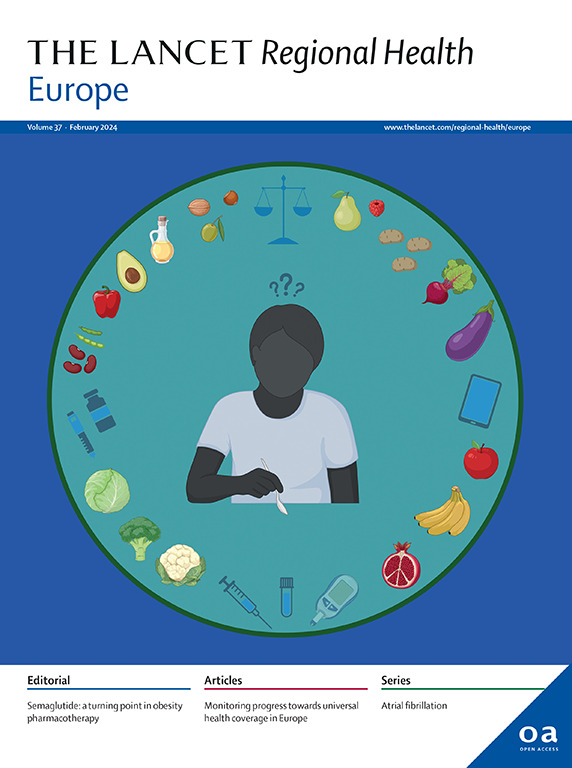Association between cardiometabolic diseases and the risk and progression of motor neuron diseases in Sweden: a population-based case–control study
IF 13.6
Q1 HEALTH CARE SCIENCES & SERVICES
引用次数: 0
Abstract
Background
The evidence on the link between cardiometabolic diseases (CMDs) and motor neuron diseases (MNDs) remains inconsistent. We aimed to determine whether there is an association of CMDs, namely, any cardiovascular disease, cardiac arrhythmia, heart failure, thromboembolic disease, hypertension, cerebrovascular disease, ischemic heart disease, diabetes mellitus type 2, and hypercholesterolemia with the risk and progression of MNDs.
Methods
We included 1463 MND patients (amyotrophic lateral sclerosis (ALS), primary lateral sclerosis (PLS), progressive spinal muscular atrophy (PSMA), and unspecified MND) diagnosed from January 1, 2015, to July 1, 2023, in Sweden according to the Swedish Motor Neuron Disease Quality Registry (i.e., cases), up to 5 MND-free population controls per case (N = 7311) who were individually matched to the cases on age and sex, and the full siblings (N = 2002) and spouses (N = 1220) of MND patients (i.e., relative controls). Conditional logistic regression models were used to estimate the risk of MND diagnosis in relation to previous CMDs, through comparing MND patients to population controls or relative controls. MND patients were followed from diagnosis to assess the role of pre-diagnostic CMDs on disease progression. A joint longitudinal-survival model was used to estimate risk of mortality (or use of invasive ventilation) in relation to CMDs after taking into account the longitudinal changes of ALS functional rating scale-revised (ALSFRS-R) in the time-to-event analysis. Hierarchical clustering with the Ward's linkage and a dissimilarity matrix created by Gower's method was used to identify clusters of MND patients with distinct phenotypes.
Findings
Among the CMDs studied, a history of diabetes mellitus type 2 (OR 0.75; 95% CI 0.62, 0.93) or hypercholesterolemia (OR 0.82; 95% CI 0.71, 0.94) more than one year before diagnosis was associated with a lower risk for MNDs. The associations persisted for more than five years before MND diagnosis. MND patients with a history of any cardiovascular disease (HR 1.43; 95% CI 1.13, 1.81), arrhythmia (HR 1.42; 95% CI 1.04, 1.93), heart failure (HR 1.79; 95% CI 1.02, 3.14), hypertension (HR 1.41; 95% CI 1.12, 1.77), or hypercholesterolemia (HR 1.28; 95% CI 1.01, 1.62) had an increased mortality risk, compared to others, after taking into consideration the longitudinal changes in ALSFRS-R. Cluster analysis identified two clusters of MND patients, where one cluster demonstrated higher age, worse functional status, and higher prevalence of CMDs at the time of diagnosis as well as a higher mortality and faster functional decline during follow-up, compared to the ones included in the other cluster.
Interpretation
Diabetes mellitus type 2 and hypercholesterolemia were associated with a lower future risk of MND. On the other hand, most of the CMDs were indicative of a poor disease progression after an MND diagnosis.
Funding
European Research Council, US Center for Disease Control and Prevention, Swedish Research Council.
瑞典心脏代谢疾病与运动神经元疾病的风险和进展之间的关系:一项基于人群的病例对照研究
背景:关于心脏代谢疾病(CMDs)和运动神经元疾病(MNDs)之间联系的证据仍然不一致。我们的目的是确定CMDs,即任何心血管疾病、心律失常、心力衰竭、血栓栓塞性疾病、高血压、脑血管疾病、缺血性心脏病、2型糖尿病和高胆固醇血症是否与mnd的风险和进展有关。方法:我们包括1463 MND患者(肌萎缩性脊髓侧索硬化症(ALS),初级侧索硬化症(PLS),进步脊髓性肌肉萎缩症(PSMA)和未指明的MND)诊断从1月1日2015年7月1日,2023年,在瑞典根据瑞典运动神经元疾病质量注册表(例如,例),5 MND-free人口控制每箱(N = 7311)他们单独在年龄和性别匹配的情况下,和完整的兄弟姐妹(N = 2002)和配偶(N = 1220)的MND患者(例如,相对的控制)。通过将MND患者与人群对照或相对对照进行比较,使用条件逻辑回归模型来估计MND诊断与既往CMDs相关的风险。从诊断开始对MND患者进行随访,评估诊断前CMDs对疾病进展的作用。在考虑ALS功能评定量表(ALSFRS-R)在事件时间分析中的纵向变化后,采用联合纵向生存模型来估计与CMDs相关的死亡风险(或使用有创通气)。采用沃德连锁的分层聚类和高尔方法创建的不相似矩阵来识别具有不同表型的MND患者群。结果:在研究的慢性糖尿病患者中,有2型糖尿病史(OR 0.75;95% CI 0.62, 0.93)或高胆固醇血症(or 0.82;(95%可信区间0.71,0.94)诊断前一年以上的患者患mnd的风险较低。这种关联在MND诊断前持续了5年多。有任何心血管疾病史的MND患者(HR 1.43;95% CI 1.13, 1.81),心律失常(HR 1.42;95% CI 1.04, 1.93),心力衰竭(HR 1.79;95% CI 1.02, 3.14),高血压(HR 1.41;95% CI 1.12, 1.77)或高胆固醇血症(HR 1.28;在考虑了ALSFRS-R的纵向变化后,95% CI 1.01, 1.62)与其他患者相比,死亡风险增加。聚类分析确定了两组MND患者,其中一组在诊断时表现出更高的年龄、更差的功能状态、更高的cmd患病率,以及在随访期间更高的死亡率和更快的功能衰退。解释:2型糖尿病和高胆固醇血症与较低的MND未来风险相关。另一方面,大多数CMDs表明MND诊断后疾病进展不良。资助:欧洲研究理事会,美国疾病控制和预防中心,瑞典研究理事会。
本文章由计算机程序翻译,如有差异,请以英文原文为准。
求助全文
约1分钟内获得全文
求助全文
来源期刊

Lancet Regional Health-Europe
Multiple-
CiteScore
19.90
自引率
1.40%
发文量
260
审稿时长
9 weeks
期刊介绍:
The Lancet Regional Health – Europe, a gold open access journal, is part of The Lancet's global effort to promote healthcare quality and accessibility worldwide. It focuses on advancing clinical practice and health policy in the European region to enhance health outcomes. The journal publishes high-quality original research advocating changes in clinical practice and health policy. It also includes reviews, commentaries, and opinion pieces on regional health topics, such as infection and disease prevention, healthy aging, and reducing health disparities.
 求助内容:
求助内容: 应助结果提醒方式:
应助结果提醒方式:


